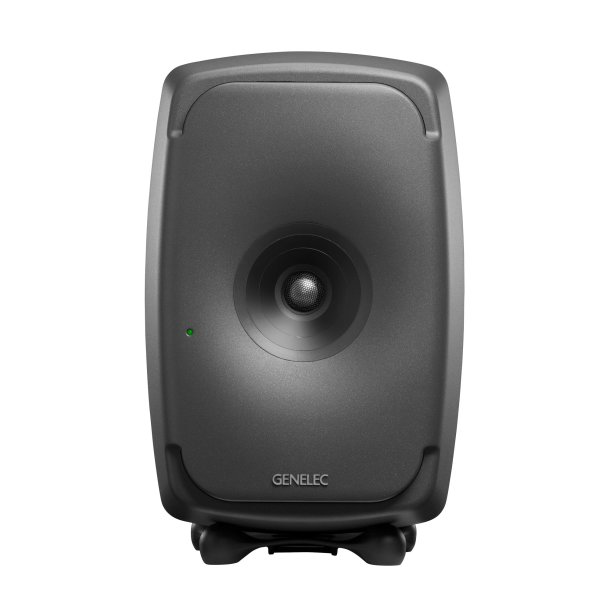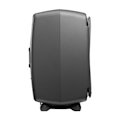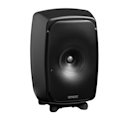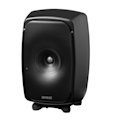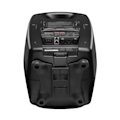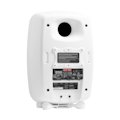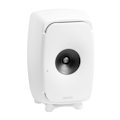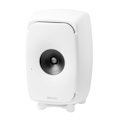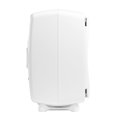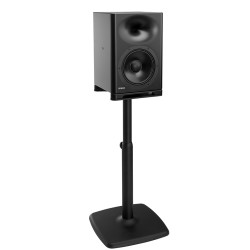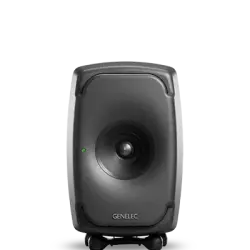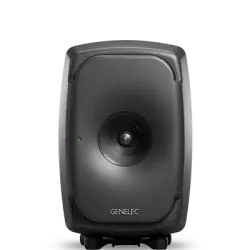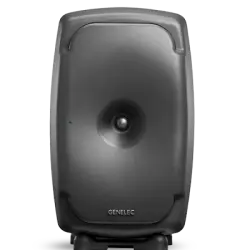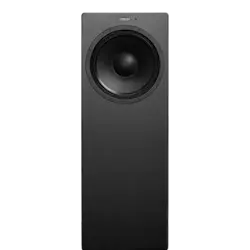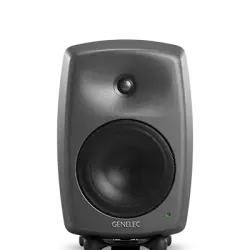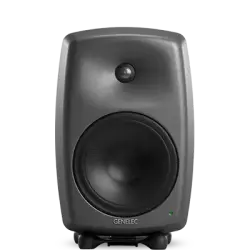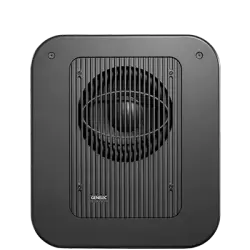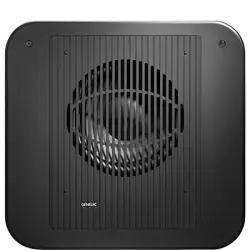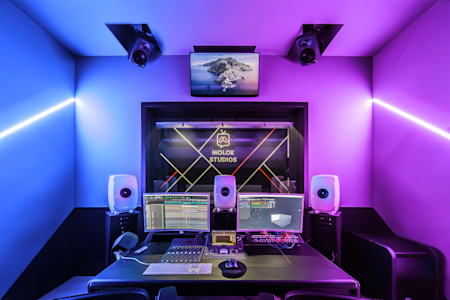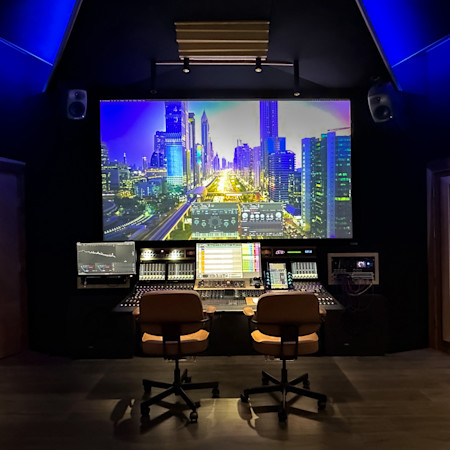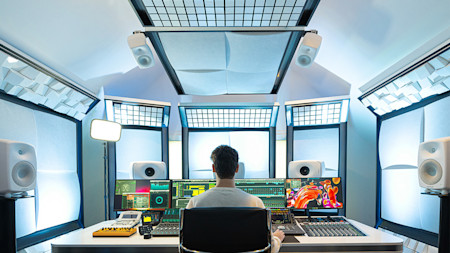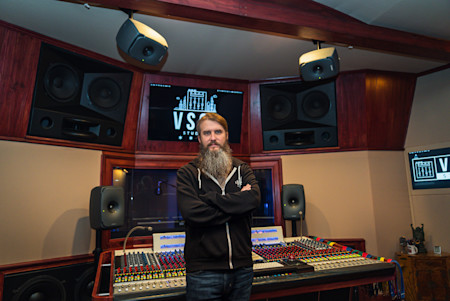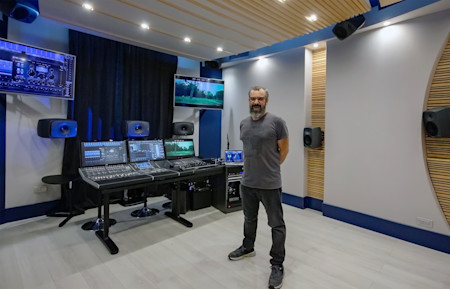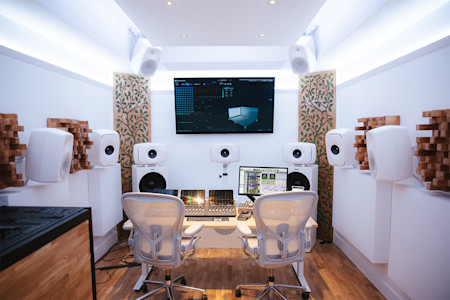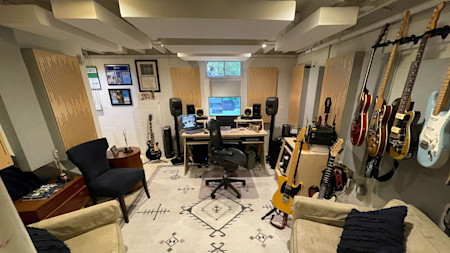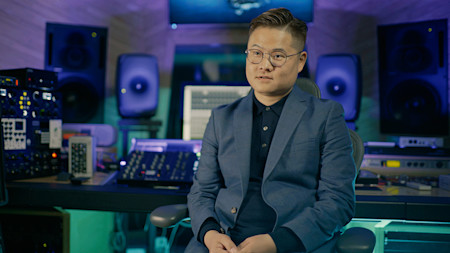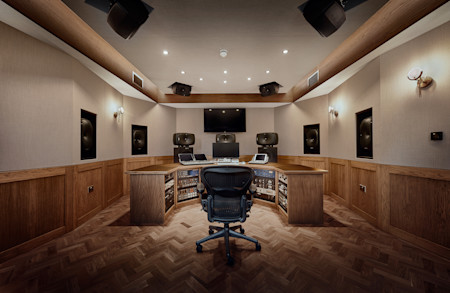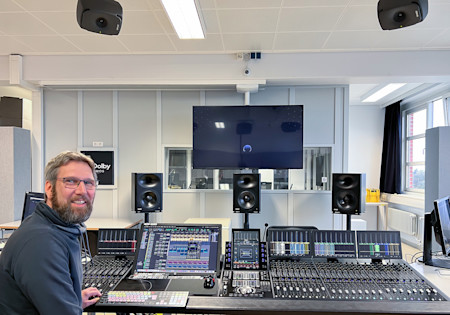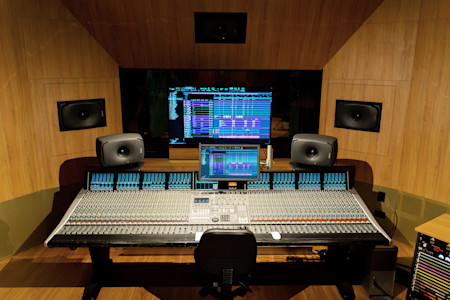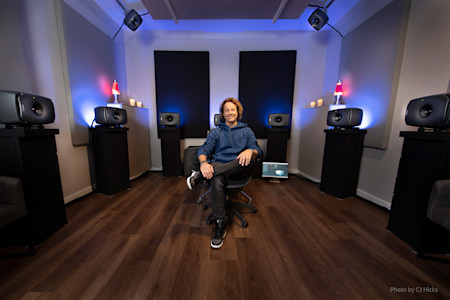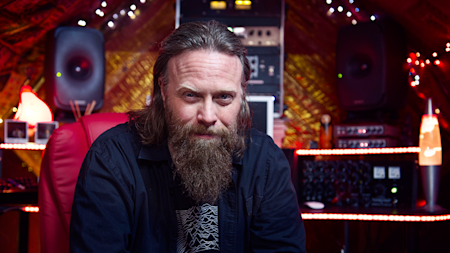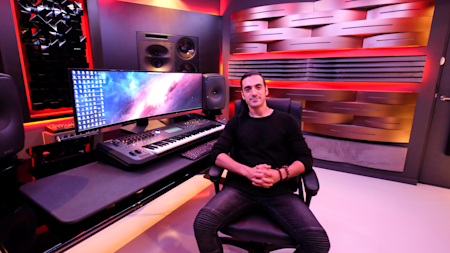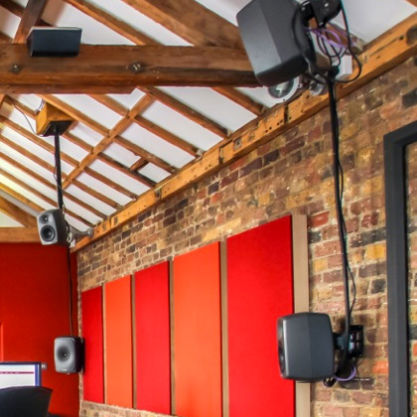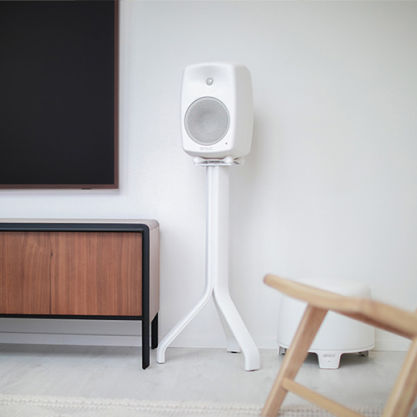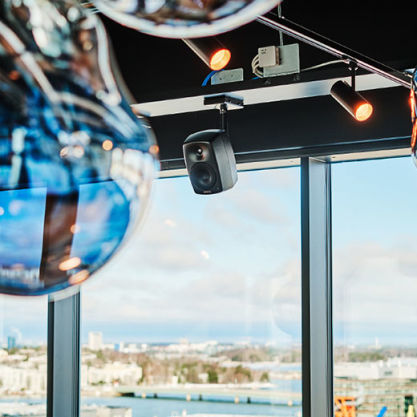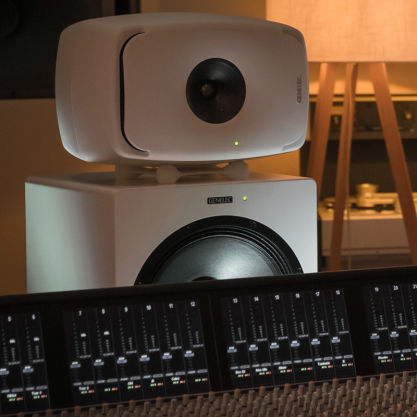Med sin unika look, sin kompakta storlek och en prestanda som inte kan beskrivas utan måste upplevas, är 8351B en riktig revolution bland trevägsmonitorhögtalare.
8351B
SAM™ Studio Monitor

Smart Active Monitor-system (SAM™)

Elementtekniken Minimum Diffraction Coaxial (MDC™)

SPL
113 dB

Frekvensomfång
32 Hz - 43 kHz (-6 dB)

Mått
H 454 x W 287 x D 278 mm, med Iso-Pod™ (vy i tum)
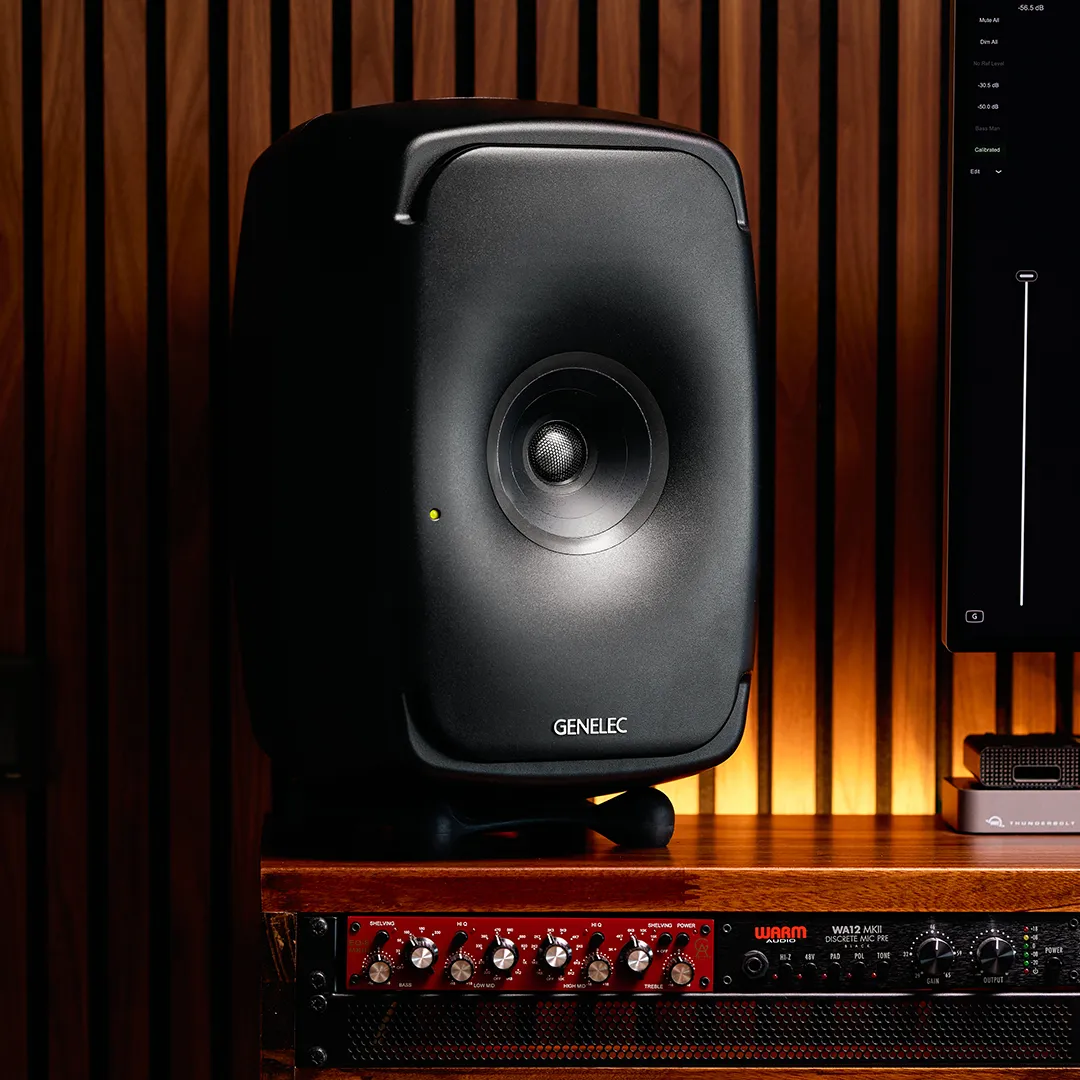
Ofärgad precision
Uppgraderade 8351B erbjuder nu ökad SPL, ytterligare EQ för rumskorrigering, utjämnad fördröjning och utökad HF-återgivning. 8351B ger samma oöverträffade ljudbild och ofärgade precision som sina mer kompakta syskonmodeller 8331A och 8341A, men med ännu mer utökat lågfrekvensdjup, samtidigt som dess höga maximala ljudtrycksnivå möjliggör längre lyssningsavstånd.
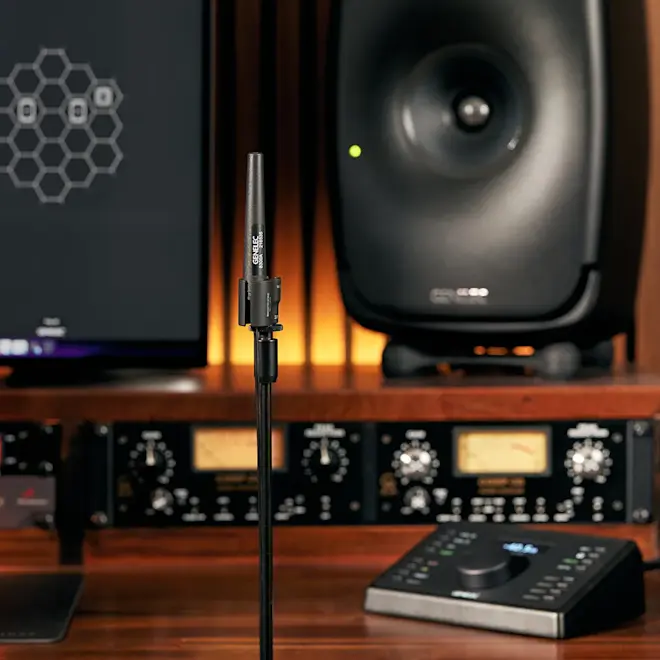
Jobba snabbare och längre
Med 8351B kan du fatta beslut snabbare och mer effektivt, men du kan också arbeta tillförlitligt i längre sessioner – detta tack vare att en onaturlig ljudbild, något som bidrar till lyssningströtthet, minimeras. I kombination med vår programvara GLM anpassas den till ditt utrymme och kompenserar för rummets negativa påverkan. Oavsett om du jobbar med mono eller immersiva format kan du vara säker på att kunna producera mixar som låter lika bra i andra rum och system.
8351B
Awards

It’s our great pleasure to report that globally respected magazine Sound On Sound have awarded our 8351B Smart Active Monitor the ‘Highly Commended’ accolade in the Studio Monitor category of this year’s SOS Awards. The honour is the direct result of votes cast by the magazine’s knowledgeable readership of engineers, producers and creatives.
We’d like to extend our sincere gratitude to everyone that voted for us, and to thank every user that’s given us valuable feedback about the 8351B – it means a great deal to us.

Genelec's The Ones monitors were awarded a "Producto del Año 2017" award by Hispasonic.

Genelec SAM™ Coaxial Studio Monitors 8331, 8341 and 8351, also known as "The Ones", were awarded with the MusicTech Gear of the Year 2017 award in "The Best Monitors" -category.

Genelec SAM™ Coaxial Studio Monitors 8331, 8341 and 8351, also known as "The Ones", were awarded with the MusicTech Gear of the Year 2017 award in "Product of the Year" -category.
Genelecs The Ones monitors were awardede a Beijing International Music & Hi-Fi Show award 2017 in the category of "Most Influential Product".
Genelec's The Ones monitors were awarded a IFTT C&C Award 2017 (International Film and Television Technology Creative & Craft Award).
Genelec's The Ones monitor series was awarded a Super AV Award 2017 in the category of Outstanding Overall Performance.
Genelec SAM™ Coaxial Studio Monitors 8331, 8341 and 8351, also known as "The Ones", were awarded a SOS Global Readers Award 2018 in "Highly Commended" -category.
Genelec's The Ones series monitors were awarded a Resolution Award 2018 in the "Monitoring" category.
Tekniska Specifikationer

SPL
113 dB

Förstärkareffekt
250 W Bass (Class D) + 150 W Midrange (Class D) + 150 W Treble (Class D)

Frekvensomfång
32 Hz - 43 kHz ("-6 dB")

Noggrannhet Frekvensomfång
± 1.5 dB (38 Hz - 20 kHz)

Storlek på högtalarelement
2 x H 101 x W 218 mm Bass + ⌀ 130 mm Midrange + ⌀ 25 mm Treble (vy i tum)

Mått
H 454 x W 287 x D 278 mm, med Iso-Pod™ (vy i tum)

Vikt
14.3 kg / 31.5 lb

Anslutningar
1 x XLR Analog Input
1 x XLR AES/EBU Input
1 x XLR AES/EBU Output
2 x RJ45 Control
8351B SAM™ Studio Monitor
SAM™ Studio Monitor
Tekniska Specifikationer
Med sin unika look, sin kompakta storlek och en prestanda som inte kan beskrivas utan måste upplevas, är 8351B en riktig revolution bland trevägsmonitorhögtalare.
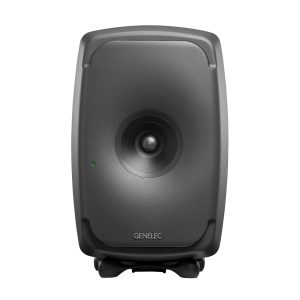
Specifikationer för system
Frekvensomfång
38 Hz - 20 kHz (± 1.5 dB)
Low cutoff -6 dB
32 Hz
High cutoff -6 dB
43 kHz
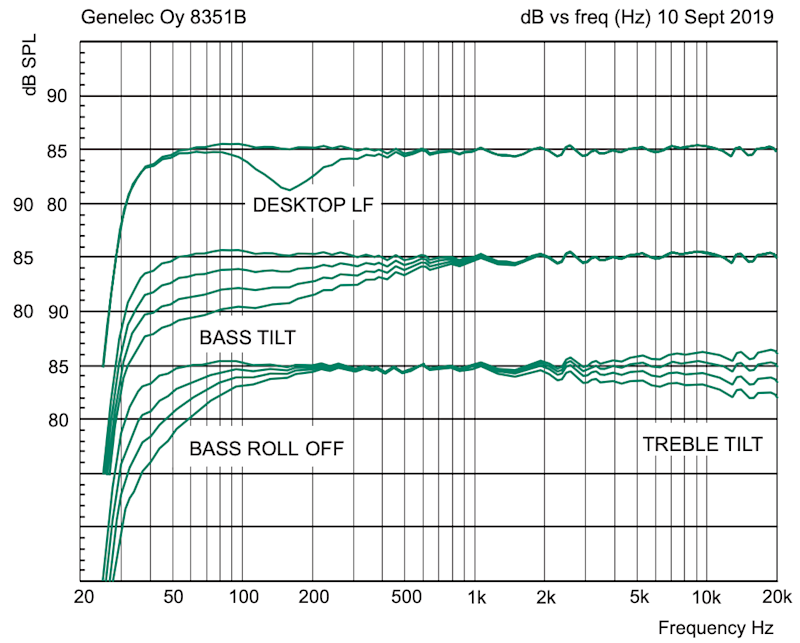
SPL
Peak SPL Maximum peak SPL output per pair on top of console at 1 m with music material.
≥118 dB
Short term max SPL Maximum short term sine wave SPL output at 1 m on axis in half space, averaged as specified (from 100 Hz to 3 kHz).
≥113 dB
Long term max SPL Maximum long term RMS acoustic output in the same conditions with IEC weighted noise (limited by driver protection circuit) at 1 m.
≥103 dB
Egenljud
Egenljud Self generated noise level in free field at 1 m on axis (A-weighted)
≤5 dB SPL
Vikt
Vikt14.3 kg (31.5 lb)
Mått
Höjd
433 mm
Höjd med Iso-Pod
454 mm
Bredd
287 mm
Djup
278 mm
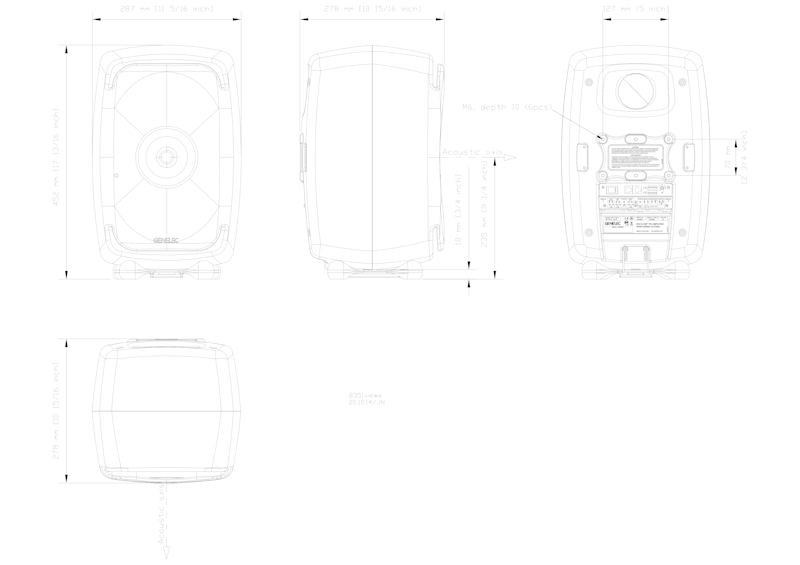
Kabinett
Material för kabinett
Die cast aluminium
Typ av kabinett
Reflex port
Högtalarelement
Typ av element
Racetrack
Dual 218 x 101 mm (85/8 x 4 in) obround cones
Antal
2
Bredd
218 mm
Höjd
101 mm
Typ av element
Coaxial
8351B midrange driver cone (coaxial)
Diameter
130 mm
Typ av element
Coaxial
8351B treble driver metal dome (coaxial)
Diameter
25 mm
Direktivitet
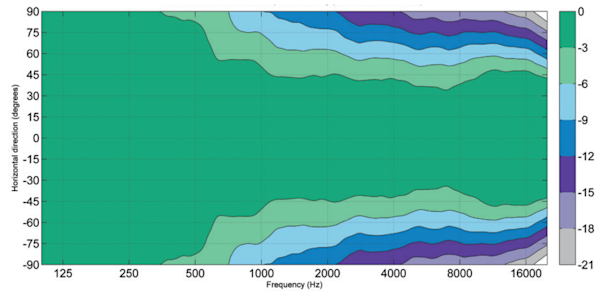
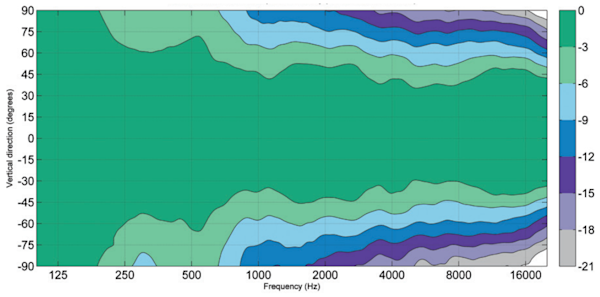
Harmonisk distorsion
> 100 Hz ≤0.5 %
Group delay
Latens vid höga frekvenser från ingång till akustisk utgång, mätt vid den analoga ingången:
Utökad faslinjäritet när GLM är OFF
3.1 ms
Utökad faslinjäritet när GLM är O
7.5 ms
I Genelecs prestandagrafik beskrivs tiden för konvertering från en elektronisk insignal till den akustiska utsignalen i en Genelec-monitor av två faktorer - latens och gruppfördröjning. Gruppfördröjningsfaktorn kan avläsas i grafiken för en specifik frekvens. Den totala frekvensspecifika in-till-utgång-fördröjningen är en summa av latens- och gruppfördröjningsfaktorerna. För att förstå betydelsen av denna totala fördröjning, tänk på att flytta bort en högtalare med 1 meter skapar en ytterligare fördröjning på cirka 3 ms.


Avsnitt Förstärkare
Förstärkare
250 W Class D
150 W Class D
150 W Class D
Nätspänning
100-240 VAC 50/60Hz
Strömförbrukning
ISS Aktiverat
≤1 W
Inaktiv
≤16 W
Full effekt
200 W
Avsnitt Signalbehandling
Anslutningar
Input Analog signal input connector XLR female (10 kOhm input load impedance).
Input XLR female (conforms to IEC 60958-4)
Output XLR male (conforms to IEC 60958-4)
2 x Control Two CAT5 (RJ45) GLM Network connectors for computer control using the Genelec Loudspeaker Manager (GLM) software.
Delningsfilter
Bass/Mid
320 Hz
Mid/Treble
2800 Hz
Produktvarianter
Produktkoder
Passande Tillbehör
Produktkoder
För mer ingående teknisk information vänligen se produktens bruksanvisning
Nyckelteknologier

Smart Active Monitor-system (SAM™)

Elementtekniken Minimum Diffraction Coaxial (MDC™)

Tekniken Acoustically Concealed Woofers (ACW™)

Aktiva delningsfilter

Tekniken Directivity Control Waveguide (DCW™)

Intelligent Signal Sensing (ISS™)

Iso-Pod™-stativ

Tekniken Minimum Diffraction Enclosure (MDE™)

Optimerade förstärkare

Skyddskretsar

Reflexportdesign

Mångsidiga monteringsalternativ
Uppkopplade Smart Active Monitor-system (SAM™) har funktioner för automatisk kalibrering till omgivningen.

Under det senaste decenniet har mängden globalt mediainnehåll ökat enormt, vilket har lett till stora förändringar i hur uppkopplade företag hanterar den ökade arbetsbördan. En ökad mängd ljudproduktioner görs nu i mindre och mer begränsade arbetsutrymmen. Detta ökar de akustiska problemen och minskar lyssningstillförlitligheten. Samtidigt måste professionella ljudtekniker kunna räkna med ett tillförlitligt och tydligt monitorhögtalarsystem som återger ljudet neutralt och utan distorsion.
Genelecs avancerade SAM-system är baserade på de stabila elektroakustiska grunderna i serierna 1200, 8000 och 7000 och utgör dagens mest avancerade och anpassningsbara monitorlösningar. De är oumbärliga för professionella ljudtekniker tack vare att de automatiskt kan anpassa sig till den akustiska miljön och kompensera för nivåer, fördröjningar och avvikelser i rummet. SAM-system kan styras via Genelecs patenterade, uppkopplade programvara Genelec Loudspeaker Manager (GLM™) som hjälper dig att bygga upp ett flexibelt och tillförlitligt monitorsystem.
Programvaran GLM 3 är ett otroligt intuitivt och kraftfullt styrsystem som hanterar anslutningen till alla SAM-studiomonitorer och -subwoofers i nätverket – upp till 30 stycken. GLM 3 har funktioner för justering av nivåer och avståndsfördröjning samt flexibel rumskorrigeringsutjämning med det robusta och toppmoderna AutoCal™-systemet för automatisk kalibrering. Alla parametrar och inställningar sparas i systemets inställningsfiler eller i varje enskild monitorhögtalare eller subwoofer om GLM-nätverket måste kopplas från.
Dessutom kan SAM-systemets samtliga akustiska egenskaper optimeras för olika tillämpningar eller kundbehov. Även om högtalarna eller projekten måste flyttas mellan olika rum kan du lita på att SAM-tekniken ger bästa möjliga konsekvens vid lyssning, med en neutral ljudbild med låg distorsion.
Genelecs SAM-system erbjuder ett heltäckande, lösningsfokuserat och uppkopplat produktsortiment med stöd för analoga och digitala signaler i mer eller mindre alla arbetsmiljöer.
Givaren Minimum Diffraction Coaxial (MDC™) återger en enastående ljudbild.
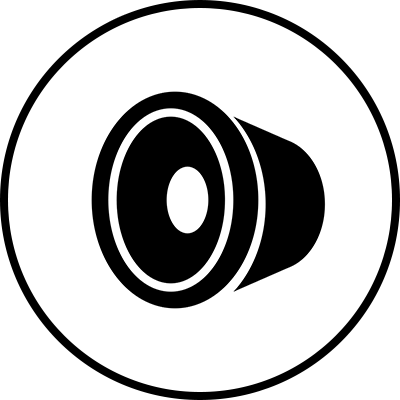
Ett vanligt problem med alla befintliga koaxiala utformningar är en något ojämn frekvensgång på grund av inneboende problem med diffraktion. Delningsfrekvensproblemet som uppstår på grund av att elementen inte har samma akustiska centrum löses genom en koaxial konfiguration. Det är här Genelecs lösning Minimum Diffraction Coaxial (MDC™) kommer in: den drar fördel av klassisk koaxial design samtidigt som den löser problemen denna design medför.
Det första steget är att minimera förskjutningen av konen, det vill säga begränsa elementets lågfrekvensbandbredd. Nästa steg är att undvika alla källor till diffraktion. MDC-designens huvudsakliga struktur består av ett integrerat mellan- och diskantregisterelement. Den synliga delen av det koaxiala elementet formar en böjd flexibel yta med domediskanten i mitten. Den inre delen sammanför konen med diskantelementet utan några akustiska ojämnheter och den yttre delen gör detsamma med konen och elementets chassi.

Eftersom det inte finns några akustiskt märkbara ojämnheter mellan diskantelementet och konen, utan bara en jämn yta, uppstår det inte heller någon diffraktion. Konens profil är noggrant optimerad för att forma en integrerad vågledare för diskantelementets spridning. Elementets yttre kant slutar i en normal Genelec-DCW i syfte att kontrollera mellanregisterspridningen. Återgivningen blir otroligt jämn både on-axis och off-axis, fri från avvikelser och med kontrollerad ljudspridning.
Detta genombrott inom koaxial design ger en förbättrad ljudbild och övergripande ljudkvalitet både on-axis och off-axis samt otroligt jämn frekvensgång, vilket gör att musikens allra finaste nyanser blir otroligt klara och tydliga.

De främsta nyheterna med teknikerna DCW™ och MDC™:
– Diffraktionsfri sammanfogning av diskant- och mellanregisterelementet
– Diffraktionsfri sammanfogning av mellanregisterelementet och DCW™-vågledaren
– En patenterad teknik för mellanregisterelementet: laminerad struktur som kombinerar en stabil kon och flexibla, gummiliknande material (inklusive själva kantupphängningen)
– Mellanregisterkonens dubbla upphängning eliminerar möjlig icke-linjär förflyttning
Fördelar:
– Jämnare frekvensgång
– Säkrar att elementen arbetar på ett sammankopplat sätt över hela den verksamma bandbredden
– Förbättrar ljudspridningskontrollen avsevärt vid kritiska frekvenser
– Erbjuder en väl avvägd dämpningseffekt för att minimera akustisk distorsion
– Optimerar användningen av området runt den främre baffeln samtidigt som utseendet och fördelarna från 8000-serien bibehålls
Tekniken Acoustically Concealed Woofers (ACW™) för kontrollerad ljudspridning ner till de lägsta frekvenserna.

Det akustiskt koaxiala trevägssystemet 8351 innehåller vår nya teknik Acoustically Concealed Woofer (ACW™). De akustiskt dolda baselementen sprider ljudet via öppningar på båda sidorna av kabinettet.
8351 har två baselement med specifik placering i syfte att utöka det koaxiala akustiska spridningskonceptet mot lågfrekvenser. När det kommer till lågfrekvensspridning och man använder två baselement som är placerade på avstånd från varandra från varandra, kommer systemet med två baselement att bete sig som ett enda stort baselement som spänner över avståndet mellan de båda elementen. Designen med dubbla baselement utökar ljudspridningskontrollen till lågfrekvenserna längs den största delen av den främre baffeln.
ACW-tekniken gör baselementens öppningar och själva elementen akustiskt osynliga för ljudspridningen från Minimum Diffraction Coaxial-elementet (MDC™) som ansvarar för mellanregister- och diskantfrekvenserna. Öppningarna för ljudet är optimerade med avseende på storlek och form för att minimera eventuella akustiska diffraktioner.
ACW-lösningen möjliggör användning av hela främre baffeln på 8351 som en enda stor Directivity Control Waveguide (DCW™) som är inbyggd i ett kabinett av typen Minimum Diffraction Enclosure (MDE™).
8351:s ACW-lösning skapar en monitorhögtalare som är fysiskt kompakt men som har samma kapacitet som ett mycket större system när det gäller lågfrekvensspridning.
Den kontrollerade lågfrekvensspridningen ger förbättrad ljudkvalitet och mindre interaktion mellan lågfrekvenserna och rummet.
Aktiva delningsfilter vid låga signalnivåer.

Elektroniska delningsfilter gör det möjligt att dela upp ljudsignalen i separata frekvensband som kan dirigeras till enskilda slutsteg, vilka sedan kopplas till specifika givare som är optimerade för ett specifikt frekvensband.
Aktiva delningsfilter finns både i digitala och analoga varianter. Genelecs digitala aktiva delningsfilter har extra funktioner för signalbearbetning, såsom skydd av element, fördröjning och utjämning.
Genelecs analoga aktiva delningsfilter innehåller elektroniska komponenter som används vid låga signalnivåer som är lämpliga för ineffekten till slutstegen. Detta till skillnad från passiva delningsfilter som används vid höga signalnivåer från slutstegets uteffekt, vilket gör att de måste hantera höga strömstyrkor och i vissa fall även hög spänning.
I ett vanligt tvåvägssystem behöver de aktiva delningsfiltren två slutsteg – ett för baselementet och ett för diskantelementet.
Designen med aktiva delningsfilter har flera fördelar:
– Frekvensgången blir oberoende av eventuella dynamiska förändringar i elementets elektriska egenskaper eller nivå.
– Ökad flexibilitet och precision för att finjustera den utgående frekvensgången för de specifika elementen.
– Varje element har ett eget slutsteg och egen signalbearbetning. Detta isolerar varje element från de signaler som hanteras av övriga element, vilket minskar problemen med intermoduleringsdistorsion och förvrängning.
– Möjlighet att kompensera för känslighetsvariationer mellan elementen.
– Möjlighet att kompensera för avvikelser i frekvens- och fasåtergivning som är kopplade till elementets egenskaper inom det avsedda passbandet.
– Den platta frekvensgång som en högkvalitativ aktiv högtalare ger är resultatet av den kombinerande effekten av delningsfilterresponsen, slutstegsresponsen och elementresponsen i ett högtalarkabinett.
Genom att använda en aktiv teknik kan man justera frekvensgången och optimera hela högtalarsystemet i olika miljöer utan att behöva använda dyra externa equalizers. Slutresultatet är ett enklare, mer tillförlitligt, effektivt, konsekvent och precist aktivt högtalarsystem.
Tekniken Directivity Control Waveguide (DCW™) för platt återgivning både on-axis och off-axis.

1983 tog Genelec ett revolutionerande steg med utvecklingen av tekniken Directivity Control Waveguide (DCW™), som på den tiden användes i ett äggformat kabinett. Genelecs DCW-teknik har utvecklats och finjusterats i över 30 år och syftet är att förbättra prestandan för direktstrålande flervägsmonitorer betydligt.
DCW-tekniken formar den utgående vågfronten på ett kontrollerat sätt, vilket möjliggör förutsägbar anpassning av ljudets spridningsmönster. Målet är att begränsa spridningsvinkeln så att ströspridning minskas för att göra spridningen jämn och enhetlig. Det leder till en utomordentligt platt frekvensgång och en enhetlig kraftrespons. Den avancerade DCW-tekniken minimerar tidiga reflektioner och ger ett brett och stabilt lyssningsområde med korrekt ljudåtergivning både on-axis och off-axis.
Minimerade tidiga reflektioner och kontrollerad, konstant direktivitet har ytterligare en viktig fördel: frekvensbalansen i rummets efterklangsfält blir mer eller mindre likadan som det direkta ljudfältet från monitorhögtalarna. Detta leder till att monitorsystemets prestanda blir mindre beroende av rummets akustiska egenskaper.
Ljudbildens djup och bredd är viktiga aspekter i alla lyssningsmiljöer, och de är inte bara viktiga on-axis utan även off-axis. Detta hjälper inte bara ljudteknikern som gör jobbet, utan även andra som befinner sig i lyssningsområdet – och det är ofta många inblandade i större kontrollrum.
Huvudsakliga fördelar med DCW™-tekniken:
– Platt återgivning både on-axis och off-axis för ett större funktionellt lyssningsområde
– Ökat förhållande mellan direkt och reflekterat ljud för minskad färgning
– Förbättrad stereo- och ”soundstage”-ljudbild
– Ökad känslighet för drivenheterna på upp till 6 dB
– Ökad högsta ljudtryckskapacitet
– Minskad distorsion för drivenheterna
– Minskade kantdiffraktioner
– Övergripande minskad distorsion
Intelligent Signal Sensing (ISS™) minskar strömförbrukningen i standby-läge.

Intelligent Signal Sensing lanserades 2013 och uppfyller både EU:s ErP-direktiv och Genelecs egna hållbarhetsåtaganden.
ISS™-kretsen övervakar högtalarens signalingång och fastställer om den används eller inte. Om ISS-kretsen inte känner av någon ljudsignal under en viss tid försätter den automatiskt högtalaren i strömsparläge så att den drar mindre än 0,5 W. När en ingångssignal upptäcks aktiveras högtalaren direkt. Högtalaren kommer att börja spara ström direkt när arbetet pausas.
En ”ISS Disable”-brytare finns på baksidan av alla högtalare, bredvid rumskorrigeringsreglagen. När högtalarens huvudströmbrytare står på ”ON” aktiveras ISS™-funktionen (strömsparläge) automatiskt.
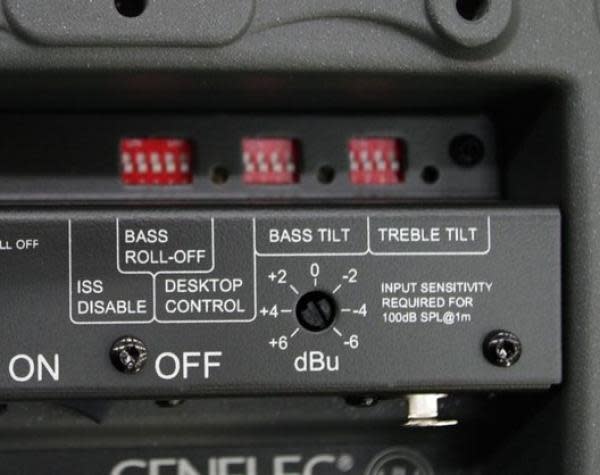
Om du inte vill använda ISS™-funktionen kan du stänga av den genom att sätta ”ISS Disable”-brytaren på den bakre panelen på ”ON”. I det här läget stängs högtalaren av och slås på endast med hjälp av huvudströmbrytaren.
Observera att man alltid kan stänga av högtalaren helt med huvudströmbrytaren.
Iso-Pod™-stativet separerar högtalaren från ytan för minimerade vibrationer och förbättrad ljudbild.

Även om det rekommenderas att använda stabila och robusta golvstativ till fristående högtalare är det vanligt att man placerar dem direkt på ett bord eller på mixerbordet.
Detta leder till flera ofördelaktiga effekter. Man glömmer ofta att rikta högtalaren mot lyssnaren, dessutom sprider sig oönskade mekaniska vibrationer från högtalaren till ytan och första ordningens reflektioner från ytan leder till kamfiltrering och därmed ojämnheter i frekvensgången.
För att lösa dessa vanliga problem har Genelec utvecklat en effektiv och praktisk lösning. Vi har designat högtalarstativet Iso-Pod™ – Isolation Positioner/Decoupler – som fästs på aluminiumkabinettet. Iso-Pod är gjort av ett särskilt flexibelt, gummiliknande material. Kabinettet står stabilt på stativet och kan flyttas längs den böjda ytan eller sidan för att luta högtalaren ±15°.
Högtalarens akustiska axel kan därmed riktas precist mot lyssnaren genom att man justerar kabinettets lutning med Iso-Pod-stativet. Isoleringen av vibrationer och de dämpande egenskaperna minskar mellanregisterfärgning orsakad av oönskade vibrationer som överförs till bärande ytor.
Den innovativa lösningen är en väsentlig del av Genelecs högtalardesign och ger massor av fördelar när det kommer till både användning av högtalaren och ljudkvaliteten.
Tekniken Minimum Diffraction Enclosure (MDE™) för ofärgad ljudåtergivning.
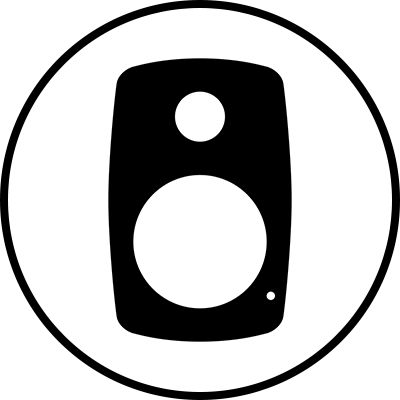
Ett vanligt problem med vanliga fristående högtalare är att ojämnheter i den främre baffeln leder till diffraktioner och att högtalarens skarpa kanter agerar som en sekundär källa för reflektionerna.
I syfte att förbättra frekvensgångens platthet och kraftresponsen från fristående högtalarsystem har Genelec designat innovativa kabinett med rundade kanter och lätt svängda linjer som är optimerade för att matcha högtalarelementens egenskaper. Förutom att leverera en utomordentligt platt frekvensgång ger dessa kabinett med minimal diffraktion en otroligt högpresterande ljudbild.
I syfte att få en elegant, välvd yta på kabinettet och för att minska dess yttermått, samtidigt som den interna volymen maximeras för bättre lågfrekvenseffekt, har vi designat ett kabinett av formgjutet aluminium. Aluminium är ett lättviktigt och stabilt material som är lätt att dämpa för att på så sätt få en mer resonansdöd konstruktion. Kabinettets väggar kan göras förhållandevis tunna, samtidigt som materialet ger bra EMC-skärmning och utgör ett utomordentligt kylelement för slutstegen. Formgjutningen görs i två delar, en främre och en bakre, för enkel separering vid eventuell service och reparation.
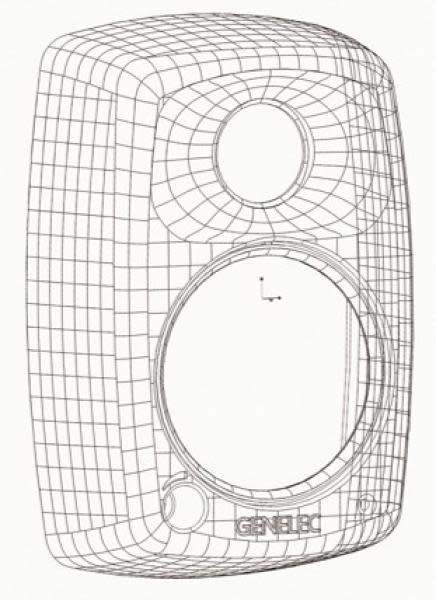
DCW-vågledaren är integrerad i MDE-kabinettet av aluminium för att ge bättre kontroll av högtalarens ljudspridning. Lågfrekvensgränsen för konstant direktivitet är beroende av vågledarens storlek, så ju större den är desto bättre kontroll ger den. Med en kontrollerad ljudspridning off-axis får man ett konsekvent lyssningsfönster, vilket är otroligt viktigt vid multikanallyssning. Kontrollerad ljudspridning minskar även första ordningens reflektioner från ytor i närheten av högtalaren, vilket bidrar till att ge konsekvent ljudåtergivning i varierande akustiska miljöer. Hela främre baffeln är lätt böjd och de akustiskt transparenta gallren är en del av det yttre kabinettets estetik, vilket gör att de smälter in väl med andra svängda ytor.

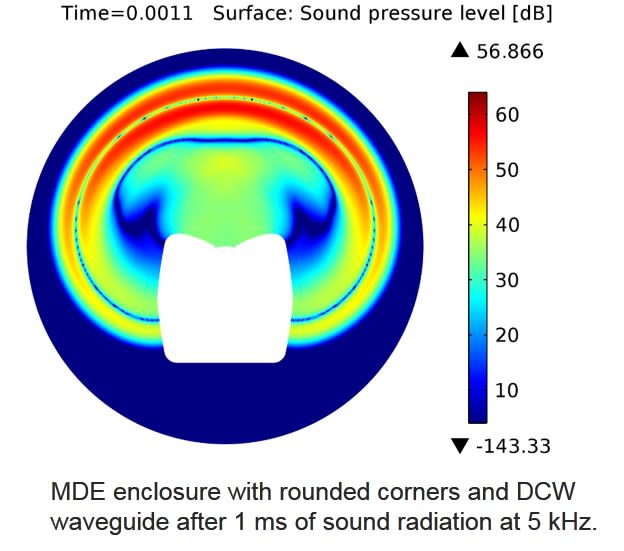
Varje givare drivs av en egen optimerad förstärkare.
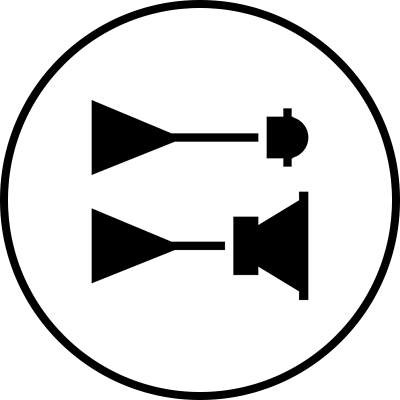
Elektroniska delningsfilter gör det möjligt att dela upp ljudsignalen i separata frekvensband som kan dirigeras till enskilda slutsteg, vilka sedan kopplas till specifika givare som är optimerade för ett specifikt frekvensband.
I ett vanligt tvåvägssystem behöver det aktiva delningsfiltret två slutsteg – ett för baselementet och ett för diskantelementet. Slutstegen är direkt kopplade till den aktiva högtalarens element, vilket gör att slutstegens belastning blir mycket enklare och välkänd. Varje elementspecifikt slutsteg har endast en begränsad frekvens att förstärka (slutsteget är placerat efter det aktiva delningsfiltret), vilket bidrar till att göra designen enkel.
Den aktiva designprincipen har flera fördelar:
– Slutstegen är direkt kopplade till högtalarens element, vilket maximerar kontrollen som utövas av slutstegens dämpning på elementets talspole. Detta reducerar i sin tur följderna av dynamiska förändringar i elementets elektriska egenskaper. Detta kan förbättra systemets transienta svar.
– Minskning av den uteffekt som krävs från slutsteget. Tack vare att ingen energi går förlorad i komponenterna till det passiva delningsfiltret minskas den uteffekt som krävs från slutsteget betydligt (med upp till 50 % i vissa fall), utan någon minskning av den akustiska uteffekten i högtalarsystemet. Detta kan bidra till att sänka kostnader och öka både ljudkvaliteten och systemets tillförlitlighet.
– Ingen förlust mellan förstärkaren och elementenheterna, vilket leder till maximal akustisk effektivitet.
– Den aktiva tekniken kan uppnå överlägsen ljudprestanda vs. storlek vs. lägre frekvensgräns.
– Alla högtalare levereras som ett fabrikskonfigurerat system (förstärkare, delningsfilterkomponenter, kabinett och elementsystem).
Sofistikerade skyddskretsar för drivenheter för säker användning.

När du arbetar med avancerad ljudproduktion är det otroligt viktigt att dina monitorsystem alltid är tillförlitliga och fungerar som de ska. Det främsta skälet till Genelecs framgångar inom sändningstillämpningar är våra produkters tillförlitlighet, och en viktig faktor bakom detta är de interna skyddskretsarna som finns i alla våra produkter – ända sedan 1978.
Skyddskretsarna förebygger fel på elementet genom att analysera signalnivåerna. Vid plötsliga toppar eller för höga nivåer under en längre tid minskas signalnivån automatiskt. Den här funktionen påverkar givetvis inte ljudkvaliteten på något sätt när högtalaren används inom ramen för dess specifikationer. Den hindrar endast avvikande ingångssignaler från att orsaka skada på högtalaren.
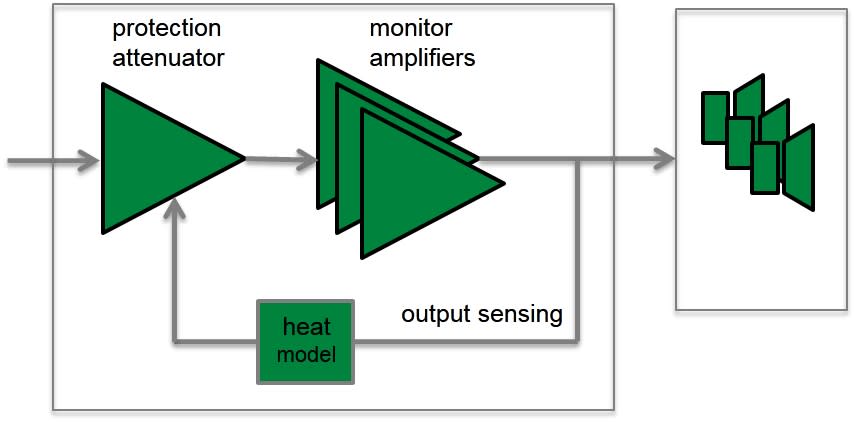
Skyddskretsarnas funktioner och fördelar:
– Minskar uteffektnivån vid behov (t.ex. när temperaturen vid elementets talspole uppnår ett gränsvärde), vilket förbättrar systemets tillförlitlighet betydligt
– Lämpliga skyddskretsar i alla högtalare och subwoofers gör det möjligt att maximera systemets utgående ljudnivå.
Avancerad reflexportdesign för utökad lågfrekvensgång.

Genelecs design med ventilerade kabinett (reflexkabinett) går tillbaka till modellen S30, vår första produkt från 1978. Reflexportarnas prestanda har förbättrats och finjusterats genom åren med syftet att öka baselementets lågfrekvensdjup och ljudtryckskapacitet för att kunna ge en utomordentligt tydlig basåtergivning.
Både elementet och ventileringen bidrar till reflexkabinettets totala ljudspridning. Det mesta av ljudspridningen kommer från högtalarelementet, men vid reflexportens resonansfrekvens är elementets förflyttning så liten att det mesta av ljudspridningen kommer ut genom reflexporten.
För att minimera luftens hastighet genom röret bör tvärsnittsarean vara stor. Detta innebär att röret måste vara långt, vilket är en utmaning när det kommer till utformningen.
Det långa, böjda röret maximerar luftflödet så att en djup basgång kan återges utan kompression. Reflexröret slutar i en bred konisk öppning på baksidan av kabinettet, vilket minimerar missljud och ger en utomordentlig basåtergivning.
Rörets böjning har även utformats noggrant för att minimera missljud, kompression och distorsion. Den inre änden av röret har en korrekt resistiv avslutning som vidare minimerar det hörbara blåsljudet och luftturbulensen.
Korrekt utformade reflexportar gör det möjligt att minska baselementets förskjutning betydligt, vilket förbättrar den linjära lågfrekvenskapaciteten.
Mångsidiga monteringsalternativ för alla installationsbehov.

Förutom utomordentlig akustisk design och avancerade alternativ för optimering av högtalarens prestanda utifrån rummet erbjuder vi många olika monteringsalternativ för enkel installation för olika användningsområden.
Vårt stora utbud av tillbehör och de fasta monteringspunkterna på baksidan av våra produkter med aluminiumkabinett erbjuder lösningar för alla vanliga installationer. M6-fästpunkter för vägg- och takfästen är integrerade i de formgjutna kabinetten.
Vissa modeller har även en 3/8"-gänga på undersidan av kabinettet för montering på ett robust mikrofonstativ. Andra större och tyngre modeller har M10-fästpunkter. Vi har även designat särskilda golvstativplattor som är kompatibla med Iso-Pod-stativet som är en del av vår produktdesign.
Tack vare dessa alternativ och möjligheter används våra högtalare på många olika platser utöver professionella inspelningsstudior, exempelvis i kommersiella projekt och AV-installationer såväl som i hem över hela världen.
Referenser
Genelec UNIO Explained | How the ecosystem offers seamless in-room and personal headphone monitoring
Genelec Visits Morten Lindberg’s Stunning Immersive Audio Studio
What is SAM technology? How will it benefit me?
What is GLM (Genelec Loudspeaker Manager)? | One Minute Masterclass Season 2 Part 9
Developing The Ones
Review: Genelec The Ones
We are The Ones
How GLM™ (Genelec Loudspeaker Manager) Software Works
Genelec UNIO Explained | How the ecosystem offers seamless in-room and personal headphone monitoring
A quick guide to our UNIO Ecosystem – which offers audio engineers seamless bridging of in-room and personal headphone monitoring. https://genelec.com/UNIO
The Genelec UNIO Ecosystem – which combines the power of our renowned GLM, SAM Monitoring and Aural ID adaptive technologies – gives audio engineers the flexibility to work anywhere, anytime, from stereo to immersive. And now, with the new UNIO Personal Reference Monitoring (PRM) solution, audio professionals benefit from the pinpoint accuracy of our pioneering active monitoring headphone solution, which combines the 9320A SAM Reference Controller with uniquely factory-calibrated 8550A Professional Reference Headphones.
To learn more, visit https://genelec.com/UNIO
Genelec Visits Morten Lindberg’s Stunning Immersive Audio Studio
In the world of immersive music recording, no-one has done more than Grammy-winning sound engineer and music producer Morten Lindberg to set the gold standard for what can be achieved in this field.
We visited Morten at his incredible studio in Oslo, Norway to talk about his approach to immersive recording, and how his new 7.1.4 Genelec monitoring system has become an essential part of his workflow.
Welcome to a fascinating insight into the world of a true immersive audio pioneer.
What is SAM technology? How will it benefit me?
What is Genelec’s Smart Active Monitor (SAM™) Technology and how will it benefit you?
What is GLM (Genelec Loudspeaker Manager)? | One Minute Masterclass Season 2 Part 9
GLM is a software for connecting, calibrating and controlling your Genelec SAM monitoring systems.
Developing The Ones
In this video we find out what the motivation was for creating Ultimate Point Source monitors, what benefits they offer, and what sets The Ones apart from every other studio loudspeaker that has gone before.
We are The Ones
Iisalmi, Finland. 19th October 2012. Our journey begins with inspiration from our users around the world. That inspiration found its way to Ilpo Martikainen’s notebook, and now we’re finally here. We wanted The Ones to point the way to the future of audio monitoring.
How GLM™ (Genelec Loudspeaker Manager) Software Works
Frustrated that your material doesn’t sound so great on other systems? In this video we show you how to calibrate the Genelec SAM™ monitors with the Genelec Loudspeaker Manager (GLM™) Software to get the most out of your room and ensuring that your mixes translate perfectly.
{"fi-FI":" ","ru-RU":" ","de-DE":" ","en-US":" ","sv-SE":" ","es-ES":" ","ja-JP":" "}
"Today we review the GENELEC 8351 studio monitors, the revolutionary 3-way Coaxial Speakers with Built-in DSP. We will discuss the importance of correct monitoring in professional studios and show how to calibrate the Speakers."
{"fi-FI":"RedStone Productions' [video review](https://youtu.be/YQgFl7H2g34 "RedStone Productions - LOOK INTO - Genelec 8351") of 8351 studio monitors.","ru-RU":"RedStone Productions' [video review](https://youtu.be/YQgFl7H2g34 "RedStone Productions - LOOK INTO - Genelec 8351") of 8351 studio monitors.","de-DE":"RedStone Productions' [video review](https://youtu.be/YQgFl7H2g34 "RedStone Productions - LOOK INTO - Genelec 8351") of 8351 studio monitors.","en-US":"RedStone Productions' [video review](https://youtu.be/YQgFl7H2g34 "RedStone Productions - LOOK INTO - Genelec 8351") of 8351 studio monitors.","sv-SE":"RedStone Productions' [video review](https://youtu.be/YQgFl7H2g34 "RedStone Productions - LOOK INTO - Genelec 8351") of 8351 studio monitors.","es-ES":"RedStone Productions' [video review](https://youtu.be/YQgFl7H2g34 "RedStone Productions - LOOK INTO - Genelec 8351") of 8351 studio monitors.","ja-JP":"RedStone Productions' [video review](https://youtu.be/YQgFl7H2g34 "RedStone Productions - LOOK INTO - Genelec 8351") of 8351 studio monitors."}
Stereo Sound Online Magazine's (JP) review of 8331 and 8341 SAM™ Studio Monitor. The review is written in Japanese and it was published in November 2017.
{"fi-FI":"Stereo Sound Online Magazine's (JP) review of 8331 and 8341 SAM™ Studio Monitor. The review is written in Japanese and it was published in November 2017.\n\nRead the full review: [Stereo Sound 8331 & 8341 Review](http://www.stereosound.co.jp/media/genelec/201712/ "Stereo Sound: 8331 and 8341 Review")","ru-RU":"Stereo Sound Online Magazine's (JP) review of 8331 and 8341 SAM™ Studio Monitor. The review is written in Japanese and it was published in November 2017.\n\nRead the full review: [Stereo Sound 8331 & 8341 Review](http://www.stereosound.co.jp/media/genelec/201712/ "Stereo Sound: 8331 and 8341 Review")","de-DE":"Stereo Sound Online Magazine's (JP) review of 8331 and 8341 SAM™ Studio Monitor. The review is written in Japanese and it was published in November 2017.\n\nRead the full review: [Stereo Sound 8331 & 8341 Review](http://www.stereosound.co.jp/media/genelec/201712/ "Stereo Sound: 8331 and 8341 Review")","en-US":"Stereo Sound Online Magazine's (JP) review of 8331 and 8341 SAM™ Studio Monitor. The review is written in Japanese and it was published in November 2017.\n\nRead the full review: [Stereo Sound 8331 & 8341 Review](http://www.stereosound.co.jp/media/genelec/201712/ "Stereo Sound: 8331 and 8341 Review")","sv-SE":"Stereo Sound Online Magazine's (JP) review of 8331 and 8341 SAM™ Studio Monitor. The review is written in Japanese and it was published in November 2017.\n\nRead the full review: [Stereo Sound 8331 & 8341 Review](http://www.stereosound.co.jp/media/genelec/201712/ "Stereo Sound: 8331 and 8341 Review")","es-ES":"Stereo Sound Online Magazine's (JP) review of 8331 and 8341 SAM™ Studio Monitor. The review is written in Japanese and it was published in November 2017.\n\nRead the full review: [Stereo Sound 8331 & 8341 Review](http://www.stereosound.co.jp/media/genelec/201712/ "Stereo Sound: 8331 and 8341 Review")","ja-JP":"Stereo Sound Online Magazine's (JP) review of 8331 and 8341 SAM™ Studio Monitor. The review is written in Japanese and it was published in November 2017.\n\nRead the full review: [Stereo Sound 8331 & 8341 Review](http://www.stereosound.co.jp/media/genelec/201712/ "Stereo Sound: 8331 and 8341 Review")"}
Hitta Din Återförsäljare

Dokumentation
Dokument
8351B Operating Manual The Ones Brochure Immersive Solutions Brochure SAM™ Series Full Line Catalogue Genelec 8351B Operating Manual - Chinese Genelec Home Studio Audio Monitoring Guide (2023)Nedladdningar
8351B - Simulation File (CLF) Line Drawing (PDF) 8351B Line Drawing (DWG) 8351B 8351B - Simulation File (GLL)Produkttester
Recording Magazine - 8351B Review RedStone Productions, March 2018 (NL) Stereo Sound: 8331 & 8341 Review, November 2017 (Japan) Ljud & Bild (online): Genelec 8351 SAM - Monitorer på steroider, April 2016 (SE) Monitor Pro Magazine (PDF), March 2016 (DK) proaudio.de: Genelec 8351A - Near/Midfield Dreiwege-Studiomonitor mit Koaxialsystem, November 2015 (DE) Resolution Awards Winners' Supplement 2015, October 2015 Bonedo Magazin (online): Genelec 8351APM Test - Studiomonitor mit Koax-Chassis, June 2015 (DE) delamar Magazin (online): Genelec 8351 Testbericht, August 2015 (DE) Sound on Sound Magazine: Genelec 8351A Active Nearfield Monitor, August 2015 (UK) Canadian Musician Magazine, July 2015 (CA) Sound & Recording Magazin (PDF): Genelec 8351A Koaxialer 3-Wege-Monitor mit DSP-System, April 2015 (DE) i-fidelity online Magazin: Genelec 8351A - Auf den Punkt , April 2015 (DE) Stereoplay online Magazin: Graue Eminenz, March 2015 (DE)"Today we review the GENELEC 8351 studio monitors, the revolutionary 3-way Coaxial Speakers with Built-in DSP. We will discuss the importance of correct monitoring in professional studios and show how to calibrate the Speakers."
RedStone Productions' video review of 8351 studio monitors.
Stereo Sound Online Magazine's (JP) review of 8331 and 8341 SAM™ Studio Monitor. The review is written in Japanese and it was published in November 2017.
Stereo Sound Online Magazine's (JP) review of 8331 and 8341 SAM™ Studio Monitor. The review is written in Japanese and it was published in November 2017.
Read the full review: Stereo Sound 8331 & 8341 Review
Ljud & Bild's online review of 8351 studio monitors.
Ljud & Bild's online review of 8351 studio monitors in Swedish. The review was published in April 2016.
Monitor Pro Magazine's (DK) review of 8351A studio monitors. Published in March 2016.
Monitor Pro Magazine's (DK) review of 8351A studio monitors. Published in March 2016.
Proaudio.de website's online review of Genelec 8351A. The review is written in German and it was published in November 2015.
Proaudio.de website's online review of Genelec 8351A. The review is written in German by Peter Kaminski. It was published on proaudio.de website in November 2015.
The Genelec 8351 studio monitor was awarded a resolution award 2015. Find out the interesting product features of the winner by reading the article "Resolution Awards Winners' Supplement 2015", published in October 2015.
Resolution Awards Winners' Supplement 2015. The article was published in October 2015.
Bonedo Magazin's (DE) online review of 8351 studio monitor. The review was published in June 2015.
Bonedo Magazin's (DE) online review "Genelec 8351APM Test: Studiomonitor mit Koax-Chassis" of 8351 studio monitor. The review was published in August 2015, and is written by Felix Klostermann. It is available in German language.
Read the full review here.
"Die findigen Finnen bieten nun einen weiteren Lautsprecher mit automatischer Anpassung an die Raumakustik. Und der hat es in sich. Erfahre im Genelec 8351 Testbericht, wie die neuartige Konstruktion klanglich überzeugt und ob sich der Kauf auch für dich und dein Studio lohnt."
Quelle: www.delamar.de
delamar Magazine's (DE) online review "Genelec 8351 Testbericht: Studiomonitor mit automatischer Raumanpassung" was published in August 2015. The review is written in German language.
"Now, with the release of the 8351A Smart Active Monitor, Genelec have not only managed to develop a revolutionary approach to the art of three-way monitor design, but they've also managed to scratch all of my monitor itches at once."
-Bob Thomas, the author of the review article
Sound on Sound Magazine's (UK) review of Genelec 8351A Active Nearfield Monitor. Written by Bob Thomas. The review was published in August 2015.
"After taking the pair of Genelec 8351 Smart Active Monitors out of their boxes and catching a glance of their sleek design and familiar shade of grey (they also come in white), I couldn't help myself; I had to plug them in and fire them up right away."
-Paul Lau, the author of the review article
Canadian Musician Magazine's (CA) review article "Genelec 8351 Smart Active Monitors" was published in July 2015. The review is written by Paul Lau.
The Sound & Recording magazine's (DE) review "Genelec 8351A Koaxialer 3-Wege-Monitor mit DSP-System" was published in April 2015. It is written by Anselm Goertz and it is available in German.
The Sound & Recording magazine's (DE) review "Genelec 8351A Koaxialer 3-Wege-Monitor mit DSP-System" was published in April 2015. It is written by Anselm Goertz and it is available in German.
"8351A und ist die erste Mutation der bereits getesteten 8260. Für diesen ausgewachsenen Dreiwege-Monitor hatten die Skandinavier einen völlig neuartigen koaxialen Mitteltöner entwickelt, der nun auch integraler Bestandteil der kleinen Schwester wurde. Die 8260 hatte allerdings noch einen klassischen Tieftöner, weshalb sich die Frage stellte, wie man auch den Bass akustisch in dieselbe Achse bekommt wie die Mittelhochton-Einheit. Die Lösung, die sich Genelec ausgedacht hat, ist ebenso simpel und neuartig wie genial"
- Raphael Vogt, the author of the review article
i-fidelity online Magazine's (DE) review of Genelec 8351A Active Nearfield Monitor. Written by Raphael Vogt. The review was published in April 2015.
"Der neue Aktivmonitor 8351A vom finnischen Studiolautsprecherspezialisten Genelec zählt zu den derzeit durchdachtesten Schallwandlern des Weltmarkts. Ebenso beeindruckend fällt auch das klangliche Ergebnis aus."
- Jürgen Schröder, the author of the review article
Stereoplay online Magazine's (DE) review of Genelec 8351A Active Nearfield Monitor. Written by Jürgen Schröder. The review was published in March 2015 and it is available in German.
hello
Got Questions?
Search our support portal for articles on frequently asked questions:
You can also submit an enquiry to our customer support team here.




